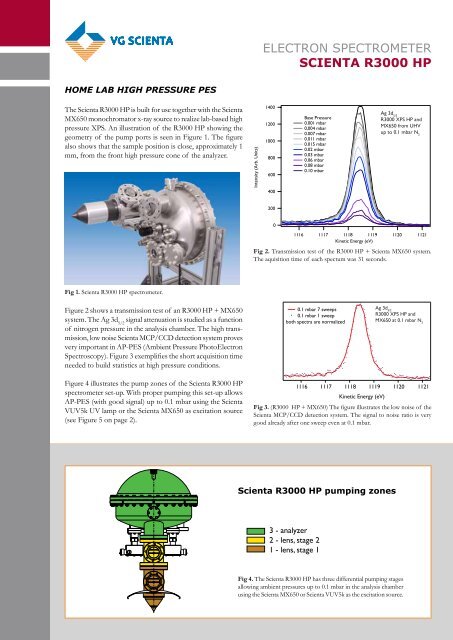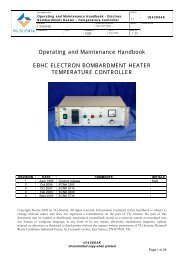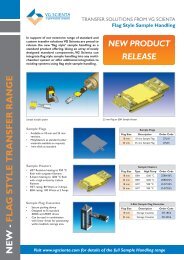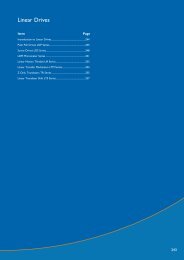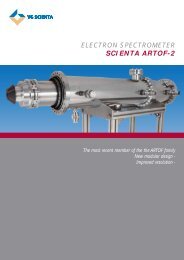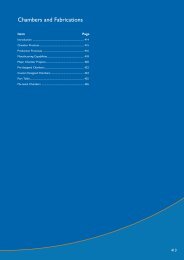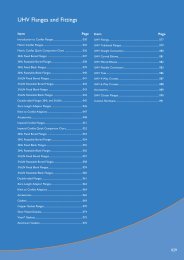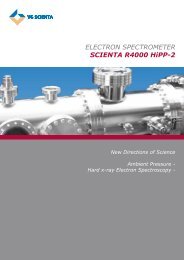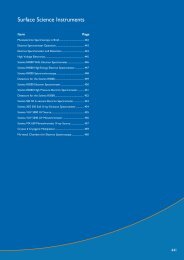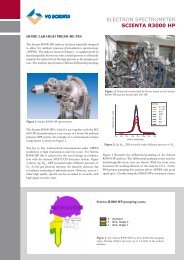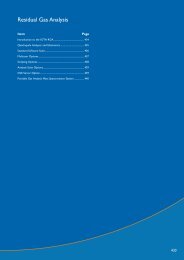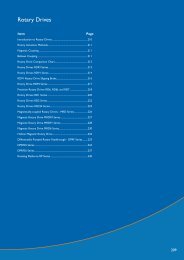ELECTRON SPECTROMETER SCIENTA R3000 HP - VG Scienta
ELECTRON SPECTROMETER SCIENTA R3000 HP - VG Scienta
ELECTRON SPECTROMETER SCIENTA R3000 HP - VG Scienta
Create successful ePaper yourself
Turn your PDF publications into a flip-book with our unique Google optimized e-Paper software.
home lab high pressure pes<br />
The <strong>Scienta</strong> <strong>R3000</strong> <strong>HP</strong> is built for use together with the <strong>Scienta</strong><br />
MX650 monochromator x-ray source to realize lab-based high<br />
pressure XPS. An illustration of the <strong>R3000</strong> <strong>HP</strong> showing the<br />
geometry of the pump ports is seen in Figure 1. The figure<br />
also shows that the sample position is close, approximately 1<br />
mm, from the front high pressure cone of the analyzer.<br />
Fig 1. <strong>Scienta</strong> <strong>R3000</strong> <strong>HP</strong> spectrometer.<br />
Figure 2 shows a transmission test of an <strong>R3000</strong> <strong>HP</strong> + MX650<br />
system. The Ag 3d 5/2 signal attenuation is studied as a function<br />
of nitrogen pressure in the analysis chamber. The high transmission,<br />
low noise <strong>Scienta</strong> MCP/CCD detection system proves<br />
very important in AP-PES (Ambient Pressure PhotoElectron<br />
Spectroscopy). Figure 3 exemplifies the short acquisition time<br />
needed to build statistics at high pressure conditions.<br />
Figure 4 illustrates the pump zones of the <strong>Scienta</strong> <strong>R3000</strong> <strong>HP</strong><br />
spectrometer set-up. With proper pumping this set-up allows<br />
AP-PES (with good signal) up to 0.1 mbar using the <strong>Scienta</strong><br />
VUV5k UV lamp or the <strong>Scienta</strong> MX650 as excitation source<br />
(see Figure 5 on page 2).<br />
Intensity (Arb. Units)<br />
<strong>ELECTRON</strong> <strong>SPECTROMETER</strong><br />
<strong>SCIENTA</strong> <strong>R3000</strong> <strong>HP</strong><br />
1400<br />
1200<br />
1000<br />
800<br />
600<br />
400<br />
200<br />
0<br />
1116<br />
Base Pressure<br />
0.001 mbar<br />
0,004 mbar<br />
0.007 mbar<br />
0.011 mbar<br />
0.015 mbar<br />
0.02 mbar<br />
0.03 mbar<br />
0.06 mbar<br />
0.08 mbar<br />
0.10 mbar<br />
1117<br />
0.1 mbar 7 sweeps<br />
0.1 mbar 1 sweep<br />
both spectra are normalized<br />
1118 1119<br />
Kinetic Energy (eV)<br />
Ag 3d 5/2<br />
<strong>R3000</strong> XPS <strong>HP</strong> and<br />
MX650 from UHV<br />
up to 0.1 mbar N 2<br />
1120<br />
1121<br />
Fig 2. Transmission test of the <strong>R3000</strong> <strong>HP</strong> + <strong>Scienta</strong> MX650 system.<br />
The aquisition time of each spectum was 31 seconds.<br />
Ag 3d 5/2<br />
<strong>R3000</strong> XPS <strong>HP</strong> and<br />
MX650 at 0.1 mbar N 2<br />
1116 1117 1118 1119 1120 1121<br />
Kinetic Energy (eV)<br />
Fig 3. (<strong>R3000</strong> <strong>HP</strong> + MX650) The figure illustrates the low noise of the<br />
<strong>Scienta</strong> MCP/CCD detection system. The signal to noise ratio is very<br />
good already after one sweep even at 0.1 mbar.<br />
<strong>Scienta</strong> <strong>R3000</strong> <strong>HP</strong> pumping zones<br />
3 - analyzer<br />
2 - lens, stage 2<br />
1 - lens, stage 1<br />
Fig 4. The <strong>Scienta</strong> <strong>R3000</strong> <strong>HP</strong> has three differential pumping stages<br />
allowing ambient pressures up to 0.1 mbar in the analysis chamber<br />
using the <strong>Scienta</strong> MX650 or <strong>Scienta</strong> VUV5k as the excitation source.
TECHNOLOGY OVERVIEW<br />
Property Specification<br />
Energy resolving power > 1000 (1350 theoretical)<br />
Angular acceptance ±15º (transmission mode)<br />
Angular range 0.5 - 20 × E P<br />
Lateral resolution 300 µm<br />
Vacuum tank µ-metal<br />
Magnetic shielding 5 mm µ-metal<br />
Pressure < 2x10 -10 mbar<br />
Baking temperature 150 ºC<br />
Working distance 45 mm<br />
Lens clearance 35º<br />
Mounting flange NW 100 CF<br />
Slits 6<br />
Circular holes Not required with CCD<br />
Detector type MCP/CCD camera<br />
Detector interface Ø 40 mm MCP<br />
Energy channels > 500 simultaneous<br />
Angular channels > 400 simultaneous<br />
Energy window 12% of pass energy<br />
Scanned mode Yes<br />
Quick mode Yes<br />
FAT mode Yes<br />
Intensity deflectors Yes, x, y<br />
ISS Option<br />
Analyser pump port Option<br />
HIGH VOLTAGE <strong>ELECTRON</strong>ICS<br />
Property Specification<br />
Temperature stability < 2 ppm/ºC (R-version)<br />
(typical 0.5 ppm/ºC)<br />
Noise (AV at analyser) < 1 ppm + < 500 µV<br />
(typical 0.5 ppm + < 200 µV)<br />
Drift < 20 ppm/year<br />
(typical 10 ppm/year)<br />
Electric isolation 6 kV<br />
Min. step size HV100 1.6 mV<br />
Min. step size DAC 200 µV<br />
DAC Bits 16<br />
Modular Yes<br />
Communication USB<br />
SWEDEN OFFICE<br />
<strong>VG</strong> <strong>Scienta</strong> AB<br />
PO Box 15120,<br />
SE-750 15 Uppsala,<br />
Sweden<br />
Phone: +46 (0)18 480 58 00<br />
USA OFFICE<br />
<strong>VG</strong> <strong>Scienta</strong> Inc<br />
235 Main Street,<br />
Pleasanton,<br />
CA 94566, USA<br />
Phone: +1-800-482-2485<br />
<strong>ELECTRON</strong> <strong>SPECTROMETER</strong><br />
<strong>SCIENTA</strong> <strong>R3000</strong> <strong>HP</strong><br />
MODELS<br />
info@vgscienta.com - www.vgscienta.com<br />
<strong>R3000</strong> XPS <strong>HP</strong><br />
Energy resolution 20 meV<br />
Kinetic energy range 10 - 1500 eV<br />
Pass Energy 20 - 200 eV<br />
<strong>HP</strong> front aperture * Yes<br />
* <strong>HP</strong> denotes High Pressure. The spectrometer can be used for standard<br />
XPS measurements but is prepared for efficient differential pumping on<br />
the lens and hemisphere to allow ambient pressure measurements up to<br />
0.1 mbar. In high pressure mode the use of a front aperture is necessary.<br />
Fig. 5. The picture shows the <strong>R3000</strong> <strong>HP</strong> and high pressure MX650<br />
set-up at the Univestity of Pennsylvania. Good signal in ambient<br />
pressure up to 0.1 mbar is supported by the spectrometer and<br />
monochromatic x-ray source. Photo courtesy: Prof. R. Carpick,<br />
University of Pennsylvania.<br />
UK OFFICE<br />
<strong>VG</strong> <strong>Scienta</strong> Ltd<br />
Maunsell Rd, Castleham Ind Est,<br />
Hastings, East Sussex,<br />
TN38 9NN, UK<br />
Phone: +44 (0)1424 851 291<br />
JAPAN OFFICE<br />
<strong>VG</strong> <strong>Scienta</strong> KK<br />
Blue Bldg, 4F<br />
2-19-7 Hongo, Bunkyo-Ku,<br />
Tokyo, 113-0033, Japan<br />
Phone: +81 (0)3 5842 5885<br />
© <strong>VG</strong> <strong>Scienta</strong>, 2009-09-23, v1.0


